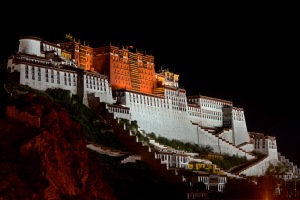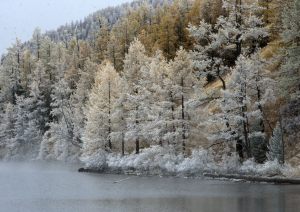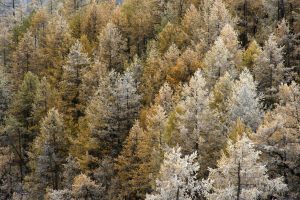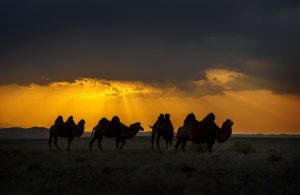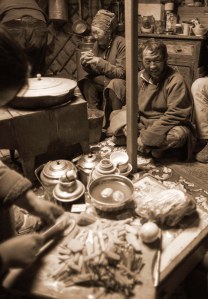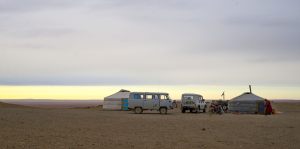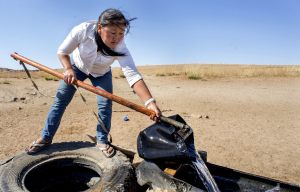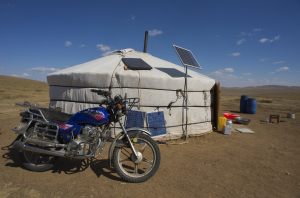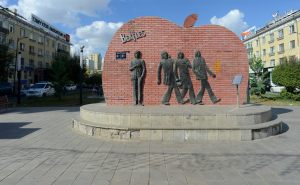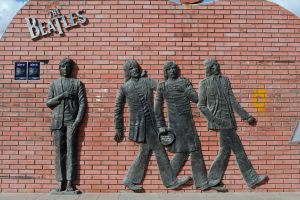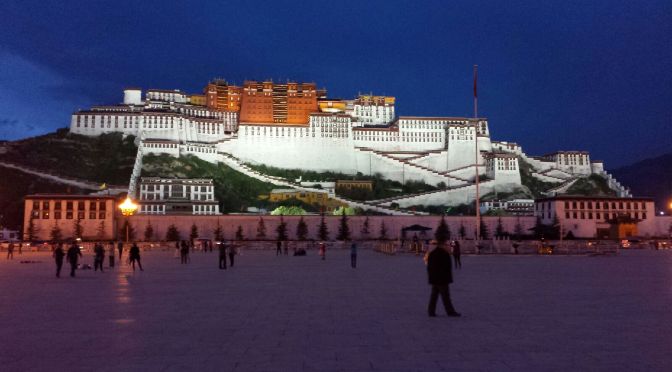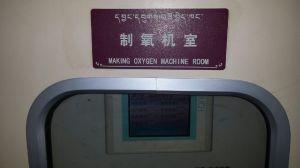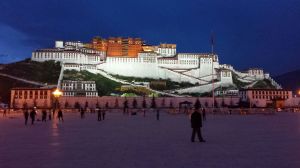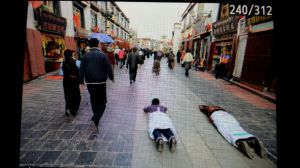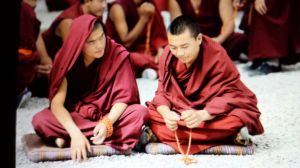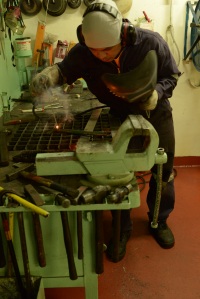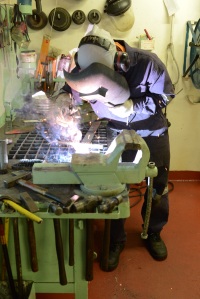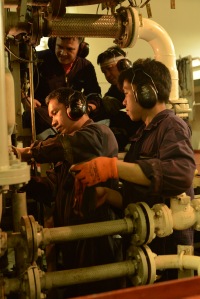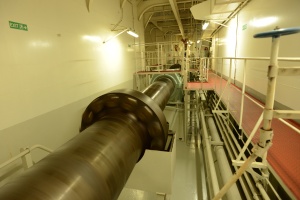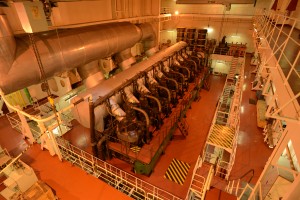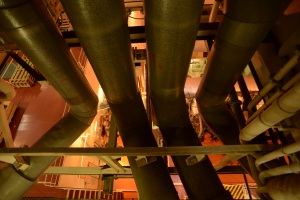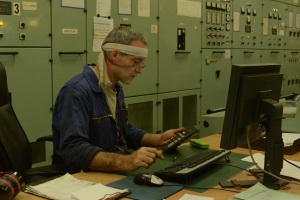Photos from Mongolia, finally… Here are the first few.
Arabic, strange beer, and pie.
Phew! I’ve made it to London, unpacked computers, found that Arabic is the most common language in my neighborhood, discovered that beer here is quite flat, and anything meaty and salty and baked in flakey crust is called pie. Hurray for London and faster internet (and pie!) I’ll be posting lots of photos and the stories of the trip soon, so stay tuned!
Taste of Tibet
Harmony
Harmony
[Guăngdõng Province, approaching Guāngzhõu]
It’s approaching the twelvth hour on this train, and the novelty has worn off, hours ago. The longest I’ve ever spent on a single traveling vehicle was 17 hours, taking the bus from Mexico City to San Cristobal de las Casas in Chiapas, Mexico. When that was finished, I felt like I’d done my time in Purgatory, and was on the superbus to Paradise. That was a long bus trip.
It’s funny, perhaps, or not, to think of the overnight train trip I just took down from Huángshān is just a warm up. A trifle. A mere half day. Nothing really, compared to what is to come. As a recovering Catholic, I just want to be sure to get as much of the Purgatory I owe out of the way. This trip is going to take care of a lot of it.
So far, it took twelve hours to go from Shanghai to Túnxī, the jump-off point for Huángshān. Then, another eighteen from Túnxī to Hong Kong. On the way back from Hong Kong, I thought I was getting a break with only twelve hours, and was surprised in the middle of the night that after twelve hours, we were only slightly past half way. This, I’ve read, is how time passes in Purgatory. We arrived back in Shanghai at 11:30 in the morning, a slight nineteen hours and fifteen minutes after we left Hong Kong.
A new long haul record.
Wahoo.
Remember, this is just the warm-up phase. From here, it’s 48 hours to Tibet, starting on Saturday, and then 48 hours back to Beijing. Still, that’s just training for the Olympics of tushe sitting. It’s something like six days plus or minus a novel and a few blog posts to cross Russia to Moscow. Oh, then there’s the continent of Europe.
I must say that it’s a relief to be on the train rather than the bus for all of this. After two solid weeks in China, plus a month three years ago, I still am not exactly sure which side of the road one drives on here. It seems like I’ve split my time between the left and right lanes, no matter which direction I’m heading.
So, let’s talk about trains, because as fun as it is to have you think I’m suffering greatly to do this trip, it’s actually not so bad…. so far… when I choose my ticket correctly….and when there’s a seat available…
Trains in China come in several different varieties. Ticket prices depend on which kind of train and which class on that train you choose.
The fastest trains in China are the C and G class trains, similar to the Shinkansen (Bullet Trains) of Japan These can reach top speeds, according to Lonely Planet, of 380 km\hour, or a little more than 200 mph. I took one from Shanghai to Sūzoū, and honestly, the trip was over before I could really get comfortable. Think of it as a commuter train with slightly cushy seats, that hums along slightly faster than one thinks it should. It’s a hybrid, a cross between the extreme efficiency of the Japanese model, and an Eastern Seaboard commuter train. The only thing is that this one is super fast.
One funny thing about the high speed trains is that they are called “Harmony”. It seems that this is the Chinese Commuist Party’s fix it all word, and it certainly applies to the trains. Like in Japan, the seats are spaceous, the cars clean and bright, and the attendents, when you can find one, somewhat more cheerful than their counterparts on the less harmonious trains. The music is even traditional and beautiful. Though, the harmony breaks down over the discordant lugie hawking that continues non-stop just about everywhere, no matter who you are. Coming from a land of pre-teen lugie hawkers, it’s just not harmonious to see a business suit clad young woman, a child carrying grandmother, and a train conductor on duty cough one up. Smoking, such a public presence everywhere I’ve been in China so far is greatly reduced on the G trains I’ve taken, though it’s still not uncommon to run into someone sneaking one in the space between the cars. Ahhh, harmony.
Next down the list are the T and K trains. These are the trains of my life, at this point. It seems that they are the most common, and cover the long distances at a price that make them the choice of the Chinese (ever growing) middle class. The T-100 I took from Hong Kong directly to ShangHai, no stops. It was comfy, and a step above the K trains I took between ShangHai, Huángshān, and Hong Kong. In American terms, think of the T as express, and the K as a slightly less than express, though slightly faster than local train. The K is the working class train, the one that moves billions of Chinese people back and forth across the vast landscapes of this country. Still, the letter class of the train seems to dictate the length of time spent in Purgatory, it’s the passenger class that determines how much suffering each trip will extract.
My ancestors are half Eastern European, mostly Polish and Ukrainian on my dad’s side, and Irish on my mother’s. I truly identify with being a New Englander, and more explicitly, a guy from the Granite State. Oh, and I grew up Catholic, too, so suffering is in my blood in just about every way. So, when I left Shanghai, and all that was available was a hard seat, I figured I could take it, right? It’s only suffering.
Hard seat wasn’t the lowest class of travel. That distinction goes to the notorious “Hell on Rails” that is the standing class. No seat for these guys. The sad thing is that some people do actually make the entire eighteen hour trip standing up. It’s just what they can afford, and getting to their destination is that important.
Okay, in my mind, I figured that hard seat meant a plywood bench. I could handle that. What hard seat really means is a carriage fitted for 116 seats, all taken, where the knees of passengers are more than touching, interwoven with wrapped packages of precious goods, valued only by those that carried them. Add in the standing class of probably 100 additional passengers, crowded into aisles and lavatories. We were a fabric, woven together by sweat, belongings, and aromas. The smoke of half toked cigarettes knotted the bunch.
I’m already huge, even back in the states I’m large enough that nobody messes with me. Here in Asia, I’m Yao Ming sized. Oh, and I’m carrying 25 pounds of camera gear along with a gallon of birdwatching stuff and a million books. Seems like someone here needs to make it into the digital age. Anyhow, The bulk of me and my stuff is embarrasing as I squeeze my way down the aisle, struggle to hoist my pack onto the luggage rack, and then sweatily stagger back up the aisle between standing class passengers who feel like they’re giving way by allowing me six inches to pass. I’m sorry, but my pelvic bone isn’t that slim, never mind what I’ve added to it over the years… I’ve been here long enough now to know that the only way through is to push. I dare not look back down the aisle at the destruction I’ve wrought. I can hear it though. I’d better keep moving and get this done as quickly as I can.
At some point, about five hours later, I am awoken from a brief nap. I can’t believe I’ve actually drifted off, fist against my chin, elbow on my knee, forehead against some plastic thing that might be a hook to hang a towel from, when the woman next to me decides she wants my spot. Uh oh. She’s suddenly loud, and confrontational. She wants the window seat, and seems ready to fight me for it. Now the whole carriage is watching, so I do the only thing I can think of, being woken from a fitful slumber…
I challenge her back in American English, brandishing my ticket. I’m in my assigned spot, and I’m staying.
Then, I quote Shakespeare, something Dan Henry, my Humanities teacher in high school promised would be useful some day. Hamlet. Yup, followed by the opening of the Canterbury Tales in Middle English. I don’t know where it came from, but it was there. Certainly nonsense to everyone on the car, but enough to buy me a second, and the laughter of my seat mates. Thanks, Mr, Henry, you were right. Surrounding travelers took up the challenge, deflecting her arguments in my stead. The woman backed off, leaving me to wonder what, exactly, had just gone down.
Maybe I should have just given her my spot. I’m going to owe a lot more time in Train Purgatory for this, but I think I’ve got that covered over the next couple of months.
Not more than ten minutes after that, the conductor comes by and points me toward the front of the train. The upgrade I’d asked for came through, and I was headed hopefully for sleeper class. Still, speaking nearly no Mandarin, I honestly had no idea where I was headed.
We stopped briefly in the dining car, which was being used as a combination conductor’s office and crew recreation lounge. No food in sight, but lots of half sleeping, card playing men and women in uniform. Lots of confusion there, but in the end, several of us travelers were awarded the much coveted red upgrade ticket, and headed off to some real sleep. I went back and grabbed my luggage, nearly crunching a toddler on a kind grandmother’s lap. It was like leaing old friends, the time spent together was so close. Such proximity, for a Westerner, is almost intimate. Several goodbyes, and I was off, making progress toward car 7, and a top bunk.
Several information sources and guidebooks I’ve read warn against that upper bunk. Don’t go there, they all say, you’re not going to like it. The conductor assigned to car 7 stood in the doorway, her cell phone lighting the precarious climb (for sure, easy 5.3 at 95 miles per hour…). Shoving my pack up into the dark, and trying not to step on the sleeping child on the first berth’s head, nor the snoring grandmother on the middle bunk’s hand, I’m thinking, “harmony”.
After six hours in the hard seat class, being able to lay down was pure bliss. I struggled to sort out my gear, not being able to sit up completely. But after a bit of a struggle, I was there.
I’m laying down in the dark.
I’m sweating, but cooling in the draft of the cabin vent, a mere 18 inches above me.
Uh, oh, what do I do with my shoes, the thought grabs me just as I’m about to fall asleep. I didn’t need to think about it for long. I’m in Asia, and so off they come.
Waves of sleep start to wash over me, it’s been a huge day. The last thought to wash over me as I drift off to the sound of the rails clacking (they really do!) was…
I’ve made it Paradise, for now.
Status Update (Keeping me honest and current!)
[Sūzhőu, Jiāngsū]
I’m starting to get behind on the updates, so I’m wondering what you are most interested in reading. Should I drop the long musings and post the day’s observations, or leave the daily sights and focus on the longer reflections? I want to hear from you, what interests you most?
The Tao
The Tao
[HuangShan, Ānnuī, China]
Taoism, an old Chinese philosophy that is hard to pin down, builds on the idea of the Tao. The Tao means “The Way”, and was an idea developed by Laotzu, who tried to explain the workings of the universe in his essay “Taote Jing”. You know, high school history… If you’ve been lucky enough to stumble across Benjamin Hoff’s The Tao of Pooh, you already know how hard it is to pin down the meaning of the Tao, even when presented through such simple characters as Pooh, Piglet, Eeyore, and Tigger.
What is the Tao, exactly, one might naturally ask.
The Tao is the way. Right now, from where I’m standing, The Way is definitely down.
Gravity, 9.8 meters per second squared. You know, high school physics…
The granite stairs in front of me roll over the edge of the cliff and drop off into the fog below. Don’t worry, I tell myself, there’s a handrail (built for very small people) that will catch you mid-knee, just before you pitch off into the mist. This is HuangShan, the Yellow Mountain, and this is the country that inspired the thinkers of the early Taoist movement. These guys understood the workings of nature. Don’t fall off.
Huagshan is also the home of the Qi.
Well, the Qi is like the Tao, it’s as hard to pin down as the mists that weave among the peaks of HuangShan like the gossamer strands of spider webs in the beaks of hummingbirds. Basically, the way I understand it (correct me if I’ve got it wrong), Qi is the spirit or essence of something. There’s a classic Chinese work by Xie He that describes the six principals of Chinese painting, and he paints (ha ha) the Qi as an attempt to put the weight of the subject, it’s depth, and it’s emotional feeling all into the silk that carries the image. But it’s much more complex, and elusive.
That’s what I came to HuangShan to experience. I wanted to see the places that inspired the Chinese classical landsccape paintings, filled with empty space and dark mountain creases and mysterious weather beaten pines. I wanted to see the places that inspired the early Taoists to try to define the universe we live in. Huangshan is living up to it’s reputation.
I left Shanghai on a night train (bound for glory?) with the lowest price ticket I could buy. Twelve hours on the train in a soft seat, which basically equates to a commuter train in the United States. While the comforts were altogether missing, my seat partner spoke a bit of English, and was willing to talk with me. She grew up in a town about an hour from HuangShan, and told me that she always thought there’d be time to visit the mountain. Now she works in IT in Shanghai, and gets home once or twice each year to visit her parents. She tells me she still hasn’t been to the mountain, but hopes to get there. There’s always time.
Through the night, the eighties pop elevator music keeps me from drifting off completely, and we pass through Sūzhõu, which my seat-mate tells me has beautiful gardens, and Nanjing, which she tells me has a terrible history. More on that later, I plan to visit both Sūzhõu and Nanjing on the way back to ShangHai. When the dawn comes under leaden skies, the lush rural landscape is so beautiful. Bamboo stands crowd kitchen gardens, and marshes blend into rice paddies. If only the garbage were not strewn across the landscape, there could be hobbits in this scene.
A little confusion at the train station in Túnxī, but with some very kind local help, I found myself on the first of a few buses that carried me off to HuangShan. My guidebook described the lodging as dismal, and mentioned that there is hot spring and that it might be a place to stay only if one might be interested in soaking. Hmmm. As if someone wouldn’t want to soak in a hot spring. I’m a guy who would take a bicycle across Kansas to get to a rumored hot spring, so my decision was made. I set off to find lodging at the hot spring.
I love hot springs. The existence of hot springs is just another sign that god loves us and wants us to be happy. I’m starting to catch on to Taoist philosophers and Qi painters, one must get the feel of the place before venturing out to understand it. I’m going to get the feel of this place by soaking in it’s mineralized hot water! My first and favorite hot spring was the Green Church hot springs near Mammoth, California, and I always seek out new hot spring experiences. From the perfection of the old town onsen in Naruko, Japan, to getting sick after dunking my adult beverage in the hot spring at Aguas Calientes, Peru, then being dumb enough to drink it anyway, I will seek out the warm waters of the earth. The hot spring at HuangShan wins the award for the most unique in the world, by my experience.
Each of the pools at this spring has a lighted display giving the temperature of the water (between 38 and 42.7 degrees Celcius), and the theme of the bath.
Yup, the theme.
At this hot spring, you can soak in green tea, or jasmine, or rose oil. Or, maybe red wine is your thing. Or, perhaps you want to soak in rice soup (the same stuff my rice maker from Japan can do, and my Japanese friends told me was for sick people to eat to gain strength…Hmmmm.). Feeling brave, and not too ticklish? How about soaking with the dead skin nibbling fish, who swarm new entrants to the pool and nibble at their feet. I tried this, and lasted less than two minutes.This was death by hot spring tickle torture, and I’m not ready to give up the ghost, yet. This spa has options, and I’m so grateful, since after spending the day on Huangshan, my muscles are going to need the medicinal qualities of the minerals of Huangshan’s hot spring. Already, I can see why the philosophers of this region were able to spend time considering the big questions.
On Sunday morning, I decided to go up the mountain. The weather promised to be perfect, with the torrential downpour easing back to a steady drizzle. This is the weather I know from home, and anyone from the Pacific Northwest would recognize the dawn this morning as the dictionary definition of Seattle in January, with a thermostat malfunction. Rainy, humid, 30 degrees C, just the kind of day to go out for a hike.
The best advice I picked up was that I should hike up to the cable car, than catch a lift to the top of the mountain. This tactic extends one’s range a bit, I was told, and it’s a lot easier to appreciate the fantastic scenery easing on down, rather than suffering on up. I pass the Mercy Light Pavilion, which was the sight of an early Taoist temple, rebuilt in the 1980’s to house the gift shop. From there, I get in the lift line for the cable car. Two hours later, I can just see the lift through the mists, looking a little old, but solid. It was a Dopelmeyer gondola circa 1986, and it lifted off into the fog, six people at a time.
From the gondola, the visibility was at times less than ten meters, and only the cable connected us with the clouds in the disorienting whiteout. Then, suddenly, out of the fog jagged fingers of granite would materialize then dissolve back into obscurity. The real challenge was going to be to put myself in the right place at the right time when a gap in the fog happened to pass through. Otherwise, the photos I was going to take would look just like San Francisco in June. Suddenly, a brief glimpse of a distant peak, then a gnarled pine, perching like a gothic gargoyle on a finger of rock, before the mists cloaked the scene again. The briefest of glimpses, all but a flicker of a memory now, gave me great hope that there would be gaps in the weather.
At the top of the gondola, it became clear instantly that this was not going to be a day of silent contemplation of the Tao. This was going to be Grand Central Station meets the Sasquatch Festival, and the only Tao I was going to find was to get in line to start the walk to the next peak’s snack shop. Ahhh, nature in China, peaceful meditation with 25 million of my new best friends, all pushing and yelling into cell phones and tour group megaphones. The pathways were narrow, the cliffs precipitous, and the handrails, as I’ve already said, were unnervingly low. The trick here was going to be to get from place to place up here without being pushed over the edge or down the granite stairways. Nobody would hear my scream over the din of the tourgroup guides and their amplified voices.
Through the occasional lightening of the cloud cover, I could make out beautiful granite formations, twisted pines clinging to the edges of the abyss with gnarly roots like the fingers of old men. I am blown away by how loud such a wild and natural place is. The amount of garbage is staggering. I make my way past landmarks with names like Jade Screen Peak, Ladder on the Clouds, Puxian Cave, and Celestial Capital Peak. Finally, pushing my way past the press of the crowd photographing each other in front of the Greeting Pine, I find the back stairs and slip into the unknown. Is this how it was for Laotzu?
Down a narrow stairway, into a cave I drop, quickly losing the crowd. The deepening mist muffles the sounds from above, and the tranquility of this place catches me by surprise. Out of the cave, the stairs decend steeply downward, and I pass several porters carrying tourist trinkets and snacks up to the gift shops above. It seems that whatever you buy at the top of the mountain made its way up on the backs of these wiry superhuman porters. Step by step, day in and day out, they make their living carrying things up that will soon make their way back down in the pockets of the tourists. Suddenly my 20 pounds of camera equipment felt a little lighter.
On a landing below, I meet a painter. There, waiting for the mists, he’s dabbing away at a sublime scene on his silk. It could be completely imaginary, since all that is visible at this point is the white water vapor of the clouds. Just then, though, the light brightens and the spine of a stony dragon looms out of the gloom. Standing Horse Peak stands tall, and I can see that the painter has matched the scene perfectly. The Qi is strong in his work.
I have arrived at The Three Islands of Pengai (Sounds like something out of a sci-fi fantasy novel, really.). These islands float in a sea of swirling vapor, and the spires, cliffs, and trees take on an otherwordly appearance that is so well captured in classic Chinese landscape painting. I never knew that there were so many different shades of gray.
Two roads diverged in a … deepening cloud of view obscuring vapor, and I chose the one less travelled by. Plunging down into an impossible slot canyon, the steps go ever on and on. The wonders keep up, step after step, and the journey downward is punctuated with moments of clarity where the terrain becomes visible through windows in the mist.
The crowds are back now, and the staggering and weaving of the older folk give testiment to the sheer volume of granite stairs on this mountain. There are reports that there may be tens of thousands of steps throughout the national park. My legs are feeling it too, this has been the ultimate stairmaster. Just when I feel I can’t take trying to pass another tour mob stumbling downward, I can make out the Mercy Light Pavilion and the end of the trail. I’m down, and can only wonder at the whole experience.
That, though, I think will be more easily done while soaking in the hot spring.
Now I know The Way.
No Thank You, Thank You
[Shanghai, China]
We arrived in Ningbo, China, and I was lingering in the ship’s office, hoping for a shore pass. Hours ticked by, as they seem to do while waiting for immigration to do the things they do in their immigration building. While ships are in port in China, it seems that touts are allowed to come up the gangway of ships just arrived, giving them the chance to unload just about anything you need, and lots of things you certainly don’t need. I was offered a car, a massage, a phone card, and the internet.
The whole internet, I was promised. All of it.
For a dollar and a half.
“No thank you!”, I tried. It didn’t work in English, and it didn’t work in Mandarin. It seems that even “no thank-you” has a price. You know, it’s really tough being ignored, and somehow, it just didn’t seem to be getting through that I don’t really need anything but the shore pass from immigration. As I retreated back onto the ship, I discovered that there’s an unwritten rule that the touts can’t go farther than the gangway area of the upper deck. Climbing the stairs to the A deck saved me.
While at sea, I had a lot of time to unpack my brain, and one thing I discovered I want to emmulate in this life is compassion. I’m not a patient man, and I’m determined (in a very driven and impatient way..) to learn to become more tolorant of the bumps life throws my way. Travelling, especially when you don’t speak the local language, is tough work. There are times, after an all night train ride in a hard seat with ’80s themed elevator music blaring, when you get off at the wrong stop, in the rain, get pick pocketed in the scrum leaving the station, when the grandma with three live chickens dangling by their legs gives you the most massive kidney blow with her elbow as she shoves her way onto the last space on the connecting bus you need when you just lose it. I’ve had that happen before. On this trip, the new compassionate me is determined (ha ha ha) to be more patient and empathetic.
I’m not going to just say “no” when things aren’t going my way on this trip. Instead, I’m going to say, “No, thank you!”.
It’s a small thing really, but I think it matters.
A day later, we arrive at the Shanghai River Port. I’m told that from the River Port it’s much easier to get to Shaghai than it is to get there from the new port. The new port in Shanghai is built on an island, and is connected to the mainland by a 14 kilometer long bridge. This is because of the Yangtzee river sediment, I’m told, which makes it difficult for the larger ships to get close enough to Shanghai. Anyhow, Captain Simon helped arrange my transfer back to terra firma with the port agent. The way it worked out, I was going to have to pay $20 as a processing fee, and a $50 fee to be transported to the immigration office. Captain Simon And I were under the impression that the immigration office was on Nanjing Road, which is in the center of Shanghai. This would be a very convenient location from which to be released into China, and would be worth (although a little more than I’d wanted to pay) the money to get to downtown Shanghai. I’d asked if there was a city bus, or something like that, and captain Simon checked with the port contacts, who quickly voiced that there was no bus (later I found out that there are several, but I would likely have ended up in Vietnam if I’d tried it myself at that point…)
Well, the immigration office might have been on Nanjing Road, but this Nanjing Road wasn’t close to the center of the city at all. It wasn’t even close to Shanghai. It was, however, very close to the Hanjin Brussels. I’d paid $50 for a mandatory 5 minute ride in a beat up old Volkawagen Fox. Welcome to China.
Next, I was told by the port agent that he’d get his friend to drive me to Shanghai for another $50, which I haggled down to $30. I got a little more for my money this time, and found myself in the center of Shanghai in about half an hour. Wahoo! I’ve made it! China at last!
Backpack on my back, I’m making my way across the sidewalk to my hotel, and I’m instant roadkill for the touting vultures.
“Pssssst! Hey mister, do you want a massage?
“No, thank you!”
Shanghai is a super modern city, having undergone a major rebuilding during the 1990’s. You’ll recognize the skyline instantly. The Pudong New Area, recently a farming area, features the futuristic Tinker-Toy-like television tower that is unmistakeable. At night, this area is so beautifully lit, so modern, and so distinctly representative of the new China. Bustling, hustling, modern and sleek, Shanghai is the fashion hub of modern China, as it has been since before it opened to the British in 1842. At the center of the opium, tea, and silk trade, Shanghai soon attracted major banks and financiers, and investors. It’s location near the mouth of the Yangtze River helped boost it’s economic importance. The banks of the Huángpū (This time I mean river banks, not houses of finance.) give evidence of Shanghai’s economic importance, with one bank featuring the colonial era strongholds of finance along the Bund, rivaled across the river by the glitzy geometric façades of newly developed modern China in Pudong.
I’ve been to Shanghai once, three years ago, It’s not my favorite city in China, being a place where new is valued over old, and the modern eclipses the history. I like the history, and if you poke around a little, you still can find some if it.
I needed to let my spirit catch up, since I’d been moving so quickly making the transfer from the ship to shore. So, I headed out to to the Shanghai Art Museum, which has some fantastic 1000 year old calligraphic scrolls and watercolors, I love this stuff, and figured spending an hour in the collections would help me come to grips with the fact that I was really, truly, completely in China. Also, I wanted to see the traditional paintings because I was planning on heading off to HuangShan, the mountain that inspired a lot of the fantastic cloud, rock spire and twisted pine tree landscapes that are so familiar in Chinese paintings.
On the way out of the hotel, another guy suggests that I get a massage. He says he knows where I should go.
“No, thank you!”, I reply with a bit less of a smile as I hurry on my way.
I next wander down to the Bund, the colonial waterfront along the river. It’s a beautiful place, and I hope that at some point soon I’ll be able to upload a few photos. I’d been walking for a couple of miles, and the heat was catchng up with me. I figured I’d find a quiet place to sit and call my wife. As I crossed the street to the waterfront, I was offered a Rolex, another massage, and the opportunity to buy a watch or three.
No, thank you.
But you really need a watch, Mister…
No…
I do not need a watch…
Um, thank you…
The crowd on the Bund was terrific. It felt like New Year’s Eve in Times Square, except this happens every night here. Watching the sun set on Pudong and seeing the lights come up against the evening sky must be in every guidebook written in a human language. It’s probably written in a few cat and dog language guidebooks as well, from what I can see.
I sat down on the first (and only) empty spot I can find, and pull out my phone. I can’t wait to talk to Amanda, it’s been a huge China filled day! As soon as I sit down, I’m approached by a man, a tourist from the far reaches of China, or maybe the city just outside of Shanghai, I don’t know. He knows a little English, and is asking if I’ll let him take a photo of his daughter, poor child, who he has in tow. It’s becoming clear that my beard and my being clearly not Chinese is a factor here.
Um, No, thank you, I’m trying to call my wife… At home, if someone has a phone to their ear, it’s usually not the best time to start up a conversation with them. At least, that is how I see it.
As I walk along, looking for another quiet (ha ha ha) spot to call my own, I’m offered another watch, and have been pointed at and giggled at by at least three teenagers, four middle aged moms, five calling birds and a great grandmother from Guăngzhõu. Clearly, I’m not in Kansas, nor Seattle, nor another place in the world than China.
And you know what?
If you asked me if there’s any other place I’d rather be right now, I’d have to say…
No. Thank you.
But the beard is going to have to go.
Engine Room
[Sea of Japan]
Today I found a place on the B deck where the vibrations of the engine of the Hanjin Brussels chattered my teeth. It was fun to stand there, brain bouncing against my skull, thinking about that engine.
Early in the journey during lunch, Mr. Aleksandrowicz, the chief engineer, mentioned that the engine has 70,000 horsepower, and that it’s one of the bigger engines out there. That number is staggering, and made me bring up the motor I use to propel my little crabbing and shrimping boat in Wollochet Bay. Awesome as my motor is, it’s just a ten horsepower Honda (which friends like to remind me is really actually 9.9 horsepower.). Think of 7,000 Honda outboards tied to the back of a cargo ship, and then you have it. The propeller alone on this ship is nine meters across. The sheer power and size of the drive system on this ship are overwhelming.
A few days ago, I got to visit the engine room for the second time. The first time was during my safety briefing on my second day, and I didn’t bring my camera. This time I did, and will try to share some of the photos and phone videos here. Still, as I check them out on my phone, they just can’t give a true sense of how powerful and magnificent the machinery aboard this ship are.
Before plunging below the upper deck into the throbbing engine room, I was issued ear protection. The noise in the engine room can be tolerated for a few seconds (I had to know, so I did take my headphones off for an instant. Cotton ears are so fun. What did you just say?). But long term exposure can do some serious damage.
The wind blasting from the engine room door would flatten a row of scarecrows, and seems to be a permanent presence. There is a hatch on the upper deck where you can look down onto the engine from above. The depth of the engine room is shocking. There are almost Seven levels below deck, and the three story engine sits near the bottom. I’ll admit, my understanding of how this thing works is minimal, but if I didn’t know better, I’d be sure it’s alive.
We descended into its lair.
The noise and vibration cannot be ignored, but the clean and bright space that is the engine room is seriously non-threatening, though one is keenly aware of the impassivity of the machine, and of the danger. The propeller’s drive shaft is a meter or more in diameter, over 70 meters long, and spins at a rate of around 60 rpm while under way, and if you wanted, you could reach out to touch it. It’s not covered, but it doesn’t take a genius to realize that a move like that here might be your last.
The main engine runs on three types of fuel, and which type of fuel is being used is dictated by the environmental laws adopted by each country we enter. While at sea, the ship is allowed to burn fuel with a high sulfur content. Closer to shore, low sulfur fuel is required. On approaches to the United States and Canada, Diesel fuel is required because it burns cleaner and leaves less toxic residue to fall into the ocean. The sulfur in the fuel contributes to acid rain, the chief engineer has told me on several occasions. Both the chief engineer and chief officer have emphasized that the regulations in the United States are strict, but necessary for the health of the planet. The thing is, they both have said on separate occasions, is that the different regulations and requirements for fuel mixtures in different ports make it confusing and difficult. The fines and penalties for making a mistake are daunting, and the chief officer tells me that airplanes are used to monitor the ships as they approach the United States. To make it easier, the officers have expressed that they wish all the ports in the world had the same regulations. It seems that the technicalities and details of the environmental restrictions worry them, because failing to comply can end up in large fines for the shipping company, and can even result in jail time for the officers. Both the chief engineer and chief officer tell me that they want to follow the regulations, but that knowing the specifics is challenging and difficult. I’m impressed at how much they seem to care about the environment and their ship’s impact upon it.
One really cool thing near the engine is the control room. Once you enter into the control area, you can remove your ear protection, and the quiet hum of the gigantic engine just outside the window is deceiving. This is the domain of the chief engineer. From the computer consoles and control panels here, most of the ship’s vital functions can be controlled.
Another interesting thing is that a community of 26 people will need potable water, and the engine crew is in charge of making sure that there is always a supply of safe fresh water for all of the crew’s needs. The fresh water on a cargo ship comes directly from the sea. The desalination plant enables the ship to take the salt out of the seawater, then run it through filters, including UV and charcoal, I think (The chief engineer is Polish, can speak Russian, German, and English extremely well, but sometimes the exact details get a little lost in translation. I wish I was better at learning languages!). Anyhow, the fresh water has a bit of a tang when you drink it, but nothing compares with downing a liter of fresh water while looking out the porthole at the sea from which it came. The water cycle does the same thing, giving us clean fresh water naturally. On board, though, we need to rely on the engine crew for this!
Back out on the engine deck, I travel deeper along the engine, feeling the thrum of the pistons like the heartbeat of an ancient behemoth. At one point, standing next to the piston tops, I can see the springs bouncing in rhythm, beautifully huge. I can feel the heat off the engine, and Mr. Schmitt, the third engineer has mentioned that the temperature in the engine room can often reach 50 degrees Celsius during tropical travels. Somehow, the oily paint smell and the warm air in the engine room is comforting. I want to stay.
Going deeper still, I come across the drive shaft. Interestingly, the layout of this ship places the engine just below and behind the superstructure, so there is still a long way, perhaps 70 meters or so between the engine and the propeller. Greased and spinning, this is the link that sends the powerful drive of the engine to the screw, or propeller that drives the ship forward at an average of 15 knots. On some ship designs, Caption Simon told me on the way into the port of Pusan, South Korea, The engine is located farther forward, making the drive shaft much longer. This can cause lots of problems he tells me, though having the exhaust stack located far behind the bridge does have a few advantages.
Despite the muffling of my headphones, my brain is full.
As I climb the nine flights of stairs, following the exhaust of a 70,000 horsepower engine up from the depths of the engine room, I’m feeling light as air. As I burst outside onto the upper deck, it’s air that I need. I pull off my protective earmuffs, and take a deep breath of that tangy salted atmosphere. As I lean against one of the shipping containers back on deck, I am thinking of what might be inside.
Whatever it might be, Mr. Aleksandrowicz will make sure it arrives, pushed through the night by 70,000 horses, harmonized into a perfect throbbing heartbeat, giving it all she’s got.
Beam me up, Mr. Aleksandrowicz.
Sundays
[East China Sea, 120 Nautical Miles East of Ningbo, China]
If you’ve ever spent a lot of time walking on the beach, you may have noticed that there is often a lot of trash that washes up, especially after a storm. Quite often, it seems, there is always a disproportionate number of spheroid objects among the trash; fishing floats, mooring bouys, and basketballs.
Yes, basketballs.
Have you ever wondered why there are so many basketballs washed up on the beach? Well, this Sunday, I found out why, and if you promise to keep it a secret, I’ll share. But first, let’s paint the background so you can get the full effect a Sunday has on a German container ship.
As I’ve mentioned before, the crew and officers on these ships work hard, and don’t make a whole lot of money by our standards in the United States. The long hours and hard work leave the crew looking forward to Sunday, the day of rest.
Sunday morning arrives, and on my way back up from breakfast, I see that the officers have gathered in the officer’s lounge, and seem to be having a very serious discussion. Okay, I think, staff meeting. A little over an hour later, I pass by the lounge again, and the officers are still there, so I assume this is an important meeting. Near lunch time, I cruise by again, since the lounge is just down the hall from my cabin. The officers are still there. This must be a very important meeting. Later that afternoon, as I quickly shuffle by the doorway, not wanting to distract anyone from the important work that certainly must be happening, when the captain yells my name.
Uh oh.
It wasn’t me that set off the fire alarm earlier… And really, I didn’t touch the engine console, even if the warning tone did go off when I was standing right next to it. Really. I walked into the officer’s lounge like it was the principal’s office, dread dripping ice down my collar.
“Would you like to join us for church?”, the captain asks. The next thing I know, Mr. Jatho, the ships’s mechanic has handed me a green bottle of Becks, and I’m sitting on a barstool next to the ship’s bell. I never did find out if church is actually how the day’s relaxation began, but the large carton of rattling green empties certainy implied that church at sea is rather different than the church I went to as a kid. After all, at my church, you only got one sip of the wine…
Meanwhile, back at the stern of the ship, another gathering is starting to form.
This afternoon, the 4 meter swell is really rolling the ship. It’s the most motion we’ve had since we’ve been at sea. With the deck wildly pitching androlling the way it is, why not join in a game of basketball? Yeah, basketball. On a cargo ship… pitching… rolling…and surrounded by water all the way to the horizon. Hmmm.
My telephone rings, and Mr. Vigo, the ship’s cook, excitedly informs me that the basketball is the next event on the high seas, and that I’d better hurry. The mostly Philippino crew love basketball, I’m told. Who is my favorite NBA player, I’m asked, over and over again.
I make my way back to the poop deck (yup, that’s what it’s called). The poop deck is the lowest deck on the outside of the cargo ship. It’s covered with shiping containers, which make a kind of roof above the winches, ropes, and other equipment used to secure the ship to the pier while in port. At sea, this area becomes the basketball court. When I arrive, the crew are wiping the steel deck around the basketball hoop with rags. There is a grimy film of water and soot from the engine, mixed with other detritus that has blown aboard during the last port stay.
Once the deck is clean(er) and dri(er), the guys begin shooting. Remember, there is a rail, and unlimited sea just outside where the three point line would be. Actually, there’s a seven inch in diameter rope laying on the deck where the three point line should be. Let the bombing begin! The engine guys really like to launch the ball from as far as possible, just behind the starboard winch. Every once in a while, the ball gets rolling across the deck, and the guys make extreme attempts to stop the ball before it gets near the stern rail and the sea beyond.
I’m thinking this is pretty much as much basketball as the ship can take, and that after a bit, we’ll end up playing a game of Horse, or something. But no, it was short work to divide up the teams, with the engine crew taking on the mess crew, plus me. Right away is was pretty clear that this was an up-tempo half court game with dubious rules. Thes guys were really good at the game, and the extra foot in height and extra 50 pounds wasn’t going to be enough to make up for the speed and agility of the engine crew. It wasn’t until after watching a behind the back give and go, leading to a perfect lay up, all done on an oily, wet steel deck pitching in a four meter swell, that I realized that the guys were all wearing flip flops with socks.
Flip flops with socks.
I’m happy to let you know that the mess crew prevailed and dinner was not withheld, despite many threats during the competition. There was a lot of laughter and fun, and I was able to see a really great moral boosting activity that the crew engages in when they have a bit of rare free time. “We’ve never lost the ball,” Mr. Vigo tells me, with a certain bit of pride, after I asked.
As we were picking up the deck rags, I noticed a black sphereoid bobbing on the waves off to starboard. It was a basketball, clear as day, rolling in the swell. It got me for a second before I was sure it wasn’t ours. Mr. Gamposilao, the cadet, was dribbling the one and only Hanjin Brussels basketball near the port winch.
Somewhere, across the rolling gray surface of the sea, another cargo ship lost it’s ball. And on some beach in Washington, or Oregon, or California, in a while, another basketball will come to rest, an eyesore to those who walk the beach. But on it’s way, it’s going to float out there with all the other lost basketballs in the wide open sea, acting as a mile markers between cultures who share a love of the game.
Sunday, the day of rest.
Even now, long after the sun has gone, the raging sounds of an emotional ping pong game drift up from the gymnasium on C deck.
And out there in the East China Sea, lost basketballs continue the long drift to the West.

